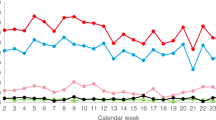Summary:
Unrelated hematopoietic stem cell transplantation (HSCT) is a recognized therapy for hematological diseases and over 8 million HLA-typed donors are ready to donate. Increased international exchanges and rapid requests through the Bone Marrow Donor Worldwide (BMDW) ask for standardized quality assurance. Since no such standards have been established to date, we tested a pilot program in order to evaluate donor availability and quality of HLA typing of the Swiss Registry.The 18500 donors of the registry have been analyzed by serology for HLA-AB and by molecular typing for HLA-DR. Through three successive annual quality control (QC) exercises, a total of 114 donor requests were sent to 13 blood transfusion centers responsible for donor recruitment asking for a blood sample. Donors were randomly selected according to recruitment periods (1988–1993; 1994–1997; 1998–2000), and to homozygosity for HLA-A and/or -B antigens. An additional 80 frozen blood samples from the repository corresponding to the three periods (n=26) and to the 2001 period (n=54) were also included in the HLA study. HLA-AB typings were done by polymerase chain reaction-sequence specific primers (PCR-SSP) and all discrepancies were retyped. The results showed that 79 samples provided by 69.3% of the requested donors were received within 14 days, and 19 samples (16.7%) were received in >14 days. Altogether, an 86% rate of donor availability was observed, independent of the recruitment period. Among the requested donors, 16 (14%) were not available: for medical reasons (two), for personal reasons (eight), for loss (one), and for an unknown reason (five). The HLA-A/B DNA typing results of 166 homozygous and 12 heterozygous blood samples showed that 437/439 (99.5%) of the assigned A/B antigens were correct. However in 36/178 donors (20.2%) an HLA-A or -B antigen had been missed (34 donors) or misassigned (two donors) by serology, with a decreasing discrepancy rate of 30% (1988–1993) to 18.5% in 2001. Assuming that HLA-A or -B homozygotes are found in 10–15% of the donors and that correct assignments have been observed in nearly 100% of the donors, an overall error rate of 4–5% would be expected for the national registry HLA-AB typing. These data show that standardized quality control for donor availability and HLA typing is feasible, and we propose that this model could be applied to the registries participating in bone marrow donor worldwide.
This is a preview of subscription content, access via your institution
Access options
Subscribe to this journal
Receive 12 print issues and online access
$259.00 per year
only $21.58 per issue
Buy this article
- Purchase on Springer Link
- Instant access to full article PDF
Prices may be subject to local taxes which are calculated during checkout
Similar content being viewed by others
References
Gratwohl A, Passweg J, Baldomero H, Urbano-Ispizua A . European Group for Blood and Marrow Transplantation (EBMT). Hematopoietic stem cell transplantation activity in Europe 1999. Bone Marrow Transplant 2001; 27: 899–916.
Anasetti C, Petersdorf EW, Martin PJ et al. Trends in transplantation of hematopoietic stem cells from unrelated donors. Curr Opin Hematol 2001; 8: 337–341.
Oudshoorn M, Cornelissen JJ, Fibbe WE et al. Problems and possible solutions in finding an unrelated bone marrow donor. Results of consecutive searches for 240 Dutch patients. Bone Marrow Transplant 1997; 20: 1011–1017.
Tiercy JM, Bujan-Lose M, Chapuis B et al. Bone marrow transplantation with unrelated donors: what is the probability of identifying an HLA-A/B/Cw/DRB1/B3/B5/DQB1-matched donor? Bone Marrow Transplant 2000; 26: 437–441.
Darke C . An overview of the Welsh bone marrow donor registry: 10 years of bone marrow donor provision. Bone Marrow Transplant 2000; 25: 771–777.
Chang YW, Hawkins BR . Comparison of serologic HLA class I results in a bone marrow donor registry with results obtained by DNA methods. Transplant Proc 1998; 30: 3486–3487.
Mytilineos J, Lempert M, Middleton D et al. HLA class I DNA typing of 215 ‘HLA-A, -B, -DR zero mismatched’ kidney transplants. Tissue Antigens 1997; 50: 355–358.
Mytilineos J, Lempert M, Scherer S et al. Comparison of serological and DNA PCR-SSP typing results for HLA-A and HLA-B in 421 Black individuals: a Collaborative Transplant Study report. Hum Immunol 1998; 59: 512–517.
Lorentzen DF, Iwanaga KK, Meuer KJ et al. A 25% error rate in serologic typing of HLA-B homozygotes. Tissue Antigens 1997; 50: 359–365.
Bozon MV, Delgado JC, Selvakumar A et al. Error rate for HLA-B antigen assignment by serology: implications for proficiency testing and utilization of DNA-based typing methods. Tissue Antigens 1997; 50: 387–394.
Schaffer M, Olerup O . HLA-AB typing by polymerase-chain reaction with sequence-specific primers: more accurate, less errors, and increased resolution compared to serological typing. Tissue Antigens 2001; 58: 299–307.
Noreen HJ, Yu N, Setterholm M et al. Validation of DNA-based HLA-A and HLA-B testing of volunteers for a bone marrow registry through parallel testing with serology. Tissue Antigens 2001; 57: 221–229.
Gourley IS, Kearns J, McKeen M et al. HLA Class I typing of volunteers for a bone marrow registry: QC analysis by DNA-based methodology identifies serological typing discrepancies in the assignment of HLA-A and B antigens. Tissue Antigens 2002; 59: 211–215.
Nicoloso de Faveri G, Kern M, Schneider P . Le Registre suisse des donneurs de moelle. Med Hyg 2002; 2389: 858–862.
Acknowledgements
We thank the volunteer donors of the Swiss Registry and all regional blood transfusion centers for their cooperation to this QC project.
Author information
Authors and Affiliations
Corresponding author
Rights and permissions
About this article
Cite this article
Tiercy, JM., Stadelmann, S., Chapuis, B. et al. Quality control of a national bone marrow donor registry: results of a pilot study and proposal for a standardized approach. Bone Marrow Transplant 32, 623–627 (2003). https://doi.org/10.1038/sj.bmt.1704229
Received:
Accepted:
Published:
Issue Date:
DOI: https://doi.org/10.1038/sj.bmt.1704229
Keywords
This article is cited by
-
Results of the EBMT activity survey 2005 on haematopoietic stem cell transplantation: focus on increasing use of unrelated donors
Bone Marrow Transplantation (2007)



